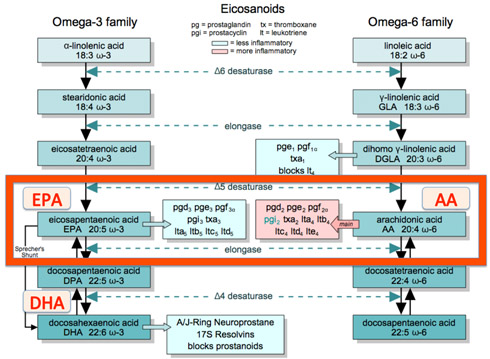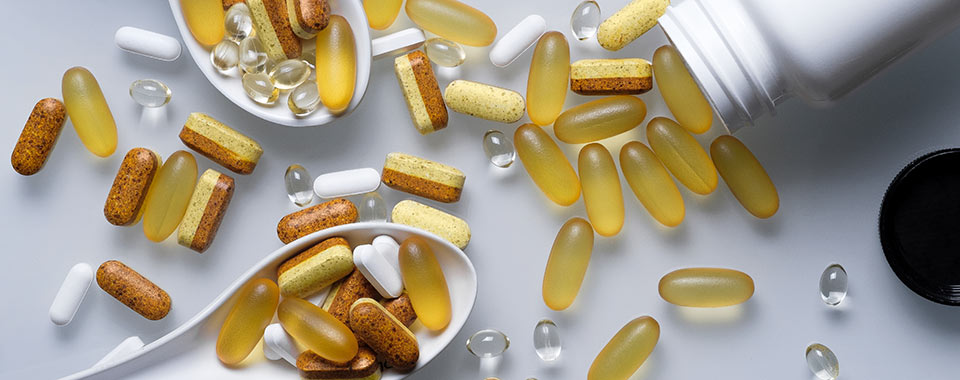Why OmegaVia has so much more EPA than DHA.
And why that’s important for your health.
How much EPA or DHA your fish oil has matters.
But it depends on what your age and health goals are – if you’re 25 and pregnant or 60 and achy.

You need a high-DHA formula if you’re:
- pregnant
- nursing
- child
- recovering from concussion
I recommend OmegaVia DHA 600 you fall in the above categories.
However, the rest of us need more EPA than DHA.
If you are trying to:
In this post, I will explain why EPA is the right natural choice for managing healthy inflammation response*.
EPA Omega-3 is Key to Managing healthy inflammation response*
Bear with me on the science for just a bit.
EPA inhibits the Omega-6 Arachidonic Acid (AA). Whoa, Skippy, you lost me at EPA!
OK, this goes back to why I rant about Omega-6 at every chance I get.
Your body breaks down Omega-3 into health-promoting substances. And on the flip side, Omega-6 breaks down into substances that are opposing to Omega-3.
If you eat a regular American diet, you have an artificially high need for EPA.
If you eat a strictly ‘paleo‘ diet with only leaves, tubers, wild caught fish and game (yes that includes liver and brain,) your Omega-3 to Omega-6 ratio will be hunky dory.
Then, you won’t need much supplemental EPA. Or supplemental anything.
But if you eat even an occasional french fry or a peanut, you’ve paved the path for an artificial need for EPA. The reality is that our diets contain 10 to 20 times more Omega-6 than they should.
The OmegaVia Formula: when we were formulating OmegaVia, we could have just as easily made a high-DHA formula. But we didn’t. After surveying the American nutritional landscape, it was clear and obvious that what Americans needed was a high-EPA product. So we made one that we could take ourselves.
Back to how EPA Omega-3 acts as a ‘inhibitor’ to the Omega-6, Arachidonic Acid (AA)
We care about this because AA is a source of several cytokines. Easy with the big words, Jack!
It just so happens that EPA and AA compete for the same enzyme in your body – it’s called delta-5-desaturase.
The more EPA you have the less enzyme you have for producing AA. So more EPA means the more you inhibit or suppress the production of AA. And and that keeps your body in balance.
EPA nips it in the bud, so to speak. I’ve called it musical chairs before. If EPA gets the chair, AA loses.
Wouldn’t DHA work just as well?
No. DHA does not inhibit AA. Why? Because DHA is a larger molecule and its structure simply won’t allow it.
All this has to do with what’s called the Eicosanoid pathway. See nifty diagram below. And Omega-3 and Omega-6 can affect these same enzymes.

Click here to see a larger (more nifty?) version of this diagram.
(This stuff is mind-bogglingly complicated and even with my chemistry background, it makes me cross-eyed.)
But wait! There’s more! If you read this now, I’ll tell you about TWO ways EPA helps for the price of one!
AA is typically stored in cell membranes. To release it from storage, you need a different enzyme called phospholipase A2 (PLA2).
Once again, there is competition between EPA and AA for this enzyme. Having high levels of EPA reduces the chance of AA being released and converted to pro-inflammatory substances.
So, once again, EPA reduces supports healthy inflammation response by keeping a little more AA locked up in the cell membrane.
Most doctors don’t spend much time thinking about the eicosanoid pathway, delta-5-desaturase or phospholipase A2 and how EPA can help.
May be that’s one reason why Dr. Oz is always pushing DHA supplements. His across-the-board recommendation of 600 mg of DHA per day is misguided and ignores the facts above. But I applaud the intent and the focus he’s brought to Omega-3.
Taking Mega Doses of EPA is Cheating
Taking high doses of EPA works. But it’s cheating and somewhat unnatural. If you’re OK with that sorta thing…
The right thing to do is eat less Omega-6.
How?
- Stop cooking with vegetable oils.
- Stop eating out – restaurants cook with Omega-6-rich soybean oil. Yes, even fancy ones.
- Stop eating processed foods – they are also cooked with soybean oil or corn oil.
There is a damn good chance that anything fried outside your house is dripping with Omega-6.
But soybean is a vegetable and has no cholesterol, Jack!
Once you get your Omega-6 intake under control – this may take several months – you will be less inflamed. Then you will be able to achieve balance without mega-doses of EPA Omega-3.
What do I mean by mega-doses?
You can actually get your AA to EPA ratio measured. Not many labs offer this service, but some do. More on that in another blog.
The balance of AA to EPA in your blood determines the level of eicosanoid imbalance that you have.
AA/EPA ratios vary depending on diet. Fish-eating older Japanese have very favorable AA/EPA ratios and also good heart health. The two facts could be connected. An American would have to eat 5 to 7 grams of Omega-3 to match the Japanese in their AA/EPA levels. More here.
If you’re wondering, that’s between 4 to 6 OmegaVia capsules per day. That’s more than we recommend.*
I am not comfortable recommending more than 3 OmegaVia pills per day. If you need more, for whatever reason, that tells me that a drastic diet makeover is in order – starting with cutting back Omega-6 and sugar.
No supplement can outrun a bad diet. Jack!
Bottom-line:
Unless you’re pregnant, nursing, or a child, it’s time to start taking more EPA (and less Omega-6.). Regardless of what Dr. Oz tells you.
In part 2, we’ll discuss more reasons why you may need more EPA than DHA. Including a study that revealed the shockingly low levels of DHA that an adult human brain absorbs every day.
*Individual results may vary. These statements have not been evaluated by the Food and Drug Administration. This product is not intended to diagnose, treat, cure, or prevent any disease. Clinical research suggests the omega-3 dosage needed to help maintain healthy triglycerides is 2000-3000 mg per day when used as part of healthy diet and exercise.



I’d love to know your opinion on the study done by Jenifer Fenton in 2010 at Michigan State University where they reported that high doses of DHA caused severe colitis and “deadly, late-stage cancer of the lining of the colon in only four weeks” in mice. I came across a 2011 article by Robert Rowen MD and Professor Brian Peskin in which they outline and site studies that show that fish oil supplementation gives no benefits at all and is actually dangerous. I never read anything negative before about fish oil and now I’m confused. Please help. Thank you, robin
Hi Robin – the Fenton study used mice, not humans. And they were very specific genetically altered mice that were bred (built?) to have an inflammatory condition. In other words, franken-mice. Inflammation is correlated to cancer so the rats had slim chance to begin with. So using GMO-mice makes it difficult to compare with humans. We have so many studies with humans taking all levels of dosages and there has been nothing significant to worry about DHA and cancer. The point remains that most people are deficient in both DHA and EPA and people should not stop supplementing with either based on this study – Jenifer Fenton made such a statement, probably after media ran amok with the story. A story like this in the hands of mass media is like handing a gun to a kid.
Whenever I hear the words Brian Peskin, I need to take a deep breath, count to 10 and think about frolicking bunnies, puppies and kittens. That’s to balance my natural reaction to anything he publishes.
For what it’s worth, please read this: http://www.omegavia.com/is-fish-oil-a-waste-of-money/ I dissect a poorly designed fish oil study that got a lot of headlines. I could easily design several clinical studies to provide one negative result after another. If a scientist cannot hold a study up to the light and spot its weaknesses and strengths, he or she should not be allowed to use the results as a fear-mongering tool. There you have it.
– Vin Kutty
Hi,
I find very interesting the omega-6 story you have here. Is there an oil out there that doesn’t have this effect that you speak of? Such as coconut or grape seed oil or safflower oil?
And what of the fish oil in a bottle that has all 3 omegas? i have seen some when i was looking for oil in a bottle not a pill. for example Nordic Naturals Omega-3.6.9 Junior it has all omegas. If what you say its true then this is counter active as omega 9 will be absorbed first then 6 then finally 3, which might never happen…
what do you think of these type of products ?
Hi Tinel – coconut oil is extremely low in Omega-6. So is pastured butter (from cows that eat grass), ghee. Seed oils (like grapeseed, safflower, canola, corn, soy etc.) are high in Omega-6.
Fish oil has very small amount of Omega-6 in it. The more purified and potent the fish oil, the less Omega-6. If you are taking Omega-3 with 6 and 9 added to it, then it has added seed oils or usually Evening primrose oils added.
I’m not sure what you mean by Omega-9 is absorbed first, then 6 and 3.
You should not be supplementing with Omega-6. One of the unhealthiest things you could possibly do: http://www.omegavia.com/omega-3-6-9/
Hello:
Should I not fry my food in olive oil? Should I use coconut oil? If not olive oil, what would you recommend for frying?
Hi Rich – olive oil is fine for frying. Coconut oil is better used for light sauteing and as a dressing, as it tends to smoke more easily. You can mix the two oils as well.
Hey Vin,
I’m seeing a lot of different stuff about how much EPA/DHA to take and I thought more is better – at the moment, I’m taking 300EPA/200DHA capsules 8 times a day for a total of 4grams combined. I saw a dosage list on Mayoclinic.com for anxiety and a host of others. How much would you suggest I take of those capsules If I want to take it for bodybuilding, brain function, anxiety and reducing chance of mental illness?
Hi Brock – don’t fall into the ‘more is better’ trap. You’ll hurt yourself. And I’m not talking about just Omega-3.
At 4 grams of Omega-3, you’re at the high end of recommended dosage. You may be better off reducing it to 3 grams and using a product with higher Omega-3 concentration, so that you’re not consuming the other non-Omega-3 fatty acids that come along with the mid-level concentration product that you’re taking.